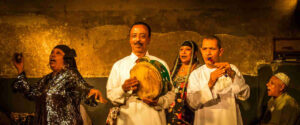The zaar ritual in Egypt (also often written as “zar”) is one of the most unique cultural and folkloric expressions in the entire country. And it is very little known among international travelers, since it is actually difficult to attend one. But it is not impossible, and in this post we explain how you can witness one of these shows, which you will surely never forget.
What is a Zaar Ritual
The first thing to do is clarify what a zaar ritual is: it is a practice halfway between music and religion, since it uses instruments during the performance but has a purely spiritual purpose: that of exorcism. Specifically, to free the body from the presence of djinn or evil spirits that may have invaded people. Its name means “visit”, for promoting this supernatural encounter.
In fact, it is a ritual that has been traditionally rejected by the most orthodox Muslims, for considering it a kind of pagan practice that is not recognized in the Koranic framework, despite the fact that the Islamic holy book does mention these djinns. The latter are genies, not always evil, who can have influence over human beings. And to keep them at bay, different amulets and practices are used, such as the famous Hand of Fatima.
In this case, the zaar ritual has its roots in the past and in other cultures of Africa, as it is known that it also has a wide tradition in countries such as Ethiopia or Sudan, from where it could have arrived in Egypt. Currently, different reports indicate that it is in serious danger of extinction, as there are fewer and fewer musician-exorcists who dedicate themselves to it.
What is one of these Rituals Like
Mainly women participate in the zaar ritual, especially the exorcist who literally leads the singing: during the performance, she goes into a trance to get in contact with these spirits or djinns, and in this way keep them away from those present, whether men or women.
In fact, although women are the ones who have this purifying power, some men (lords or sheikhs) also participate in the ritual, in this case playing musical percussion and string instruments, such as the tamboura (six-string lyre) to create the right atmosphere for the exorcism. Often, the predominant rhythm is the one known as ayub (two-beat), but not only.
On stage, the women and lords display their rhythms and songs, which sometimes include prayers used in Sufi mystical practices, bringing this ritual closer to others that are also of great tradition, such as the performances of the whirling dervishes. In any case, the movements of its protagonists are spontaneous here, motivated by the ritual itself and the environment, in which the public can also participate.
Where to See a Zaar Ritual in Egypt
As we said, it is difficult to witness a zaar ritual in Egypt, as there are fewer and fewer musician-exorcists who dedicate themselves to it. The rejection by the most orthodox Muslims may be behind this slow decline, but it still survives in places like the
In addition, private performances can also be organized on demand, contacting these musician-mediums directly. So, if you are curious about witnessing one of these rituals between the artistic and the supernatural, you can contact Egipto Exclusivo and we will study the possibilities of attending one during your trip.



